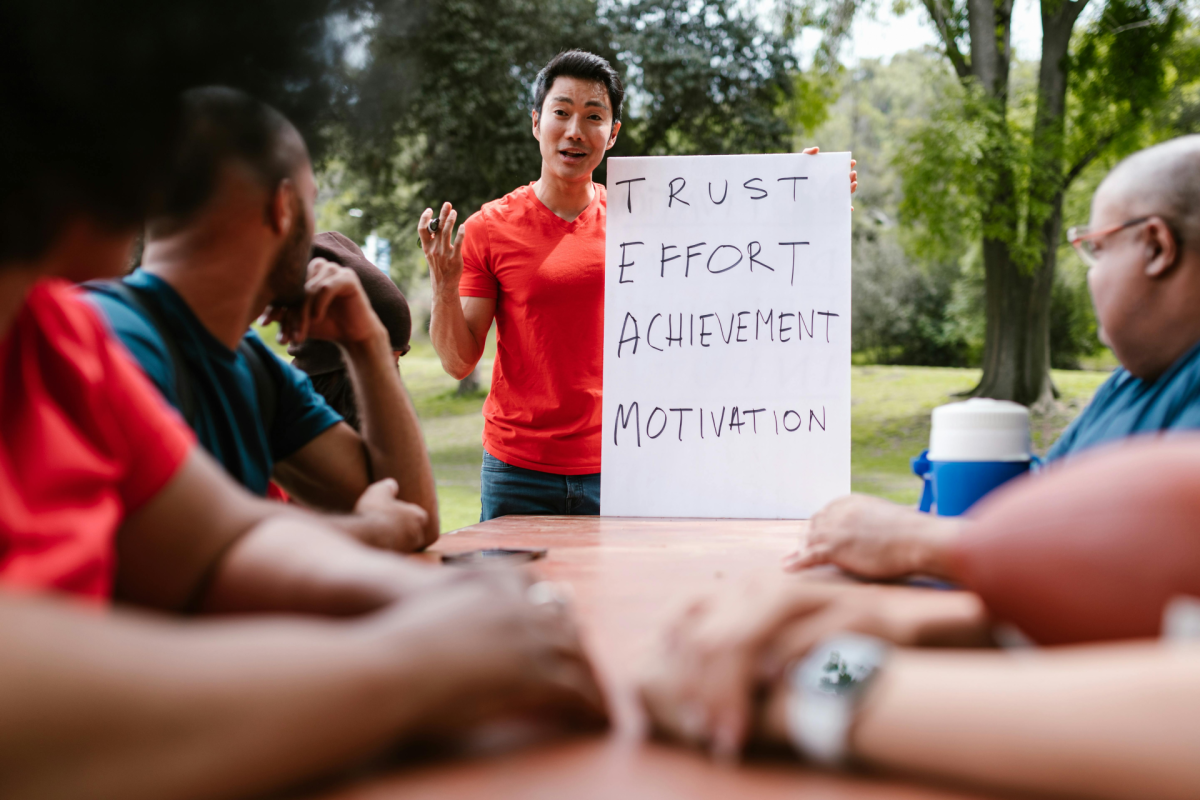Lead The Team To Success
Leading a team to success requires a unique set of qualities and strategies. From effective communication and strong decision-making to being inspirational and organized, a successful team leader must possess a diverse skill set.
“Talent wins games, but teamwork and intelligence wins championships.” -Michael Jordan
We will explore the essential qualities of a successful team leader, strategies for leading a team to success, and common challenges that leaders may face.
Whether you are a seasoned leader or aspiring to lead a team, we will provide valuable insights to help you navigate the path to success.

Leading a Team to Success: Understanding and Methods
Leading a team to success involves more than just overseeing tasks; it requires guiding, motivating, and inspiring the group toward achieving common goals and celebrating accomplishments. Effective leadership is the cornerstone of driving a team toward victory.
A good leader sets the tone for the team, providing direction, clarity, and support to ensure that every member functions cohesively towards the collective objectives.
By offering guidance, a leader can help team members navigate challenges, make informed decisions, and stay focused on the end goal.
Motivation is crucial in maintaining team morale and encouraging individuals to push their limits.
Influential leaders recognize the significance of establishing well-defined, attainable objectives that motivate their team to pursue excellence and cultivate a mindset of ongoing growth. Moreover, they promote an environment where work and enjoyment coexist, encouraging a fun, lighthearted atmosphere contributing to team members’ happiness and overall well-being.
A successful team leader embodies effective communication, strong decision-making abilities, inspiration, efficiency, and adaptability, guiding the team toward accomplishments and success.
As a team leader, fostering a positive, enjoyable work culture is crucial for maintaining high morale and engagement within the group.
Qualities of a Successful Team Leader
A successful team leader embodies effective communication, strong decision-making abilities, inspiration, efficiency, and adaptability, guiding the team toward accomplishments and success.
Effective communication is crucial for a team leader to convey goals, expectations, and feedback. By fostering open communication channels, team members feel valued and understood, leading to better collaboration and problem-solving.
Strong decision-making abilities enable leaders to make timely and practical choices, guiding the team toward success. Inspirational leadership motivates team members to perform at their best and strive for excellence.
Efficiency in delegating tasks and resources optimally enhances productivity. Adaptability allows a leader to navigate challenges and changes effectively, ensuring the team remains resilient and innovative.
Effective Communication Skills
Practical communication skills are paramount for a team leader to clearly convey vision, goals, and expectations, ensuring smooth coordination and understanding among team members.
Clear communication empowers leaders to inspire their team members, provide guidance, and foster a collaborative environment. A leader can clearly articulate objectives and strategies to align everyone toward a common goal.
Effective communication also plays a crucial role in management by facilitating feedback mechanisms, resolving conflicts, and building trust within the team.
When mentoring or coaching team members, communication helps offer constructive feedback, identify strengths and weaknesses, and nurture individual growth and development.
Strong Decision-Making Abilities
Strong decision-making abilities empower a team leader to make timely and practical choices that drive progress, manage challenges, and lead the team toward success.
Practical decision-making skills play a crucial role in the leadership journey by allowing the leader to navigate complex situations, prioritize tasks efficiently, and foster a culture of accountability and transparency within the team.
By making informed decisions, a leader inspires confidence among team members and ensures that all efforts are aligned toward achieving common goals. For instance, when overseeing team tasks, a leader with solid decision-making skills can quickly identify areas for improvement, allocate resources effectively, and provide guidance that propels the team toward success.
“Team leadership is the secret that makes common people achieve uncommon results.” -Ifeanyi Onuoha
Inspirational and Motivational
Being inspirational and motivational allows a team leader to empower and encourage team members, fostering a success-driven environment where goals are achieved through collective effort.
An inspiring leader sets the tone for the team, creating a positive atmosphere that boosts morale and performance. A leader can instill a sense of belief and determination in team members by sharing personal success stories or showcasing examples of perseverance in the face of challenges.
Motivating team members through constructive feedback and recognition of their efforts also plays a crucial role in maintaining high levels of engagement and commitment. When team members feel valued and supported, they are more likely to take risks, explore new ideas, and strive for excellence, ultimately leading to overall team success.
Organized and Efficient
An organized and efficient team leader fosters progress through streamlined coordination, ensuring tasks are managed effectively, and goals are achieved with precision.
A leader can create a cohesive and goal-oriented team by setting clear objectives, delegating responsibilities appropriately, and establishing efficient communication channels. The team functions like a well-oiled machine when each team member understands their role and how it contributes to the overall goals.

Effective coordination ensures that deadlines are met, resources are utilized optimally, and conflicts are resolved swiftly, leading to successful outcomes. For example, in a project where team members collaborate seamlessly, deadlines are consistently achieved, and client satisfaction soared.
Resilient and Adaptable
Resilience and adaptability enable a team leader to navigate challenges, drive progress, and achieve milestones, showcasing the ability to overcome obstacles and lead the team toward success.
In times of uncertainty, a resilient leader remains steady and composed, inspiring confidence in their team and instilling a sense of stability. By demonstrating resilience, a leader sets an example for others, showing that setbacks are temporary roadblocks that can be overcome with determination and a positive mindset.
Adaptability allows a leader to pivot strategies swiftly in response to changing circumstances, ensuring that the team stays on track toward their goals despite unforeseen challenges. Embracing these traits empowers the leader and motivates the team to persevere and excel together.
Strategies for Leading a Team to Success
Strategies for leading a team to success involve clear goal definition, fostering a positive team culture, encouraging collaboration, providing support, and continuously evaluating and adjusting tactics to achieve desired outcomes.
By establishing clear goals early on, team members have a roadmap to follow, ensuring everyone is aligned on the overall objectives. A positive team culture fosters a supportive environment where individuals feel valued and motivated to contribute their best.
“Great things in business are never done by one person. They’re done by a team of people.” —Steve Jobs
Collaboration is crucial in maximizing team potential by combining diverse perspectives and skills, leading to innovative solutions. Providing support involves offering guidance, resources, and encouragement to team members, empowering them to overcome challenges and make informed decisions.
Effective leadership strategies emphasize the importance of proactive communication, genuine empathy, and active listening, ultimately fostering mutual respect and trust within the team.”
Clearly Define Goals and Expectations
A clear definition of goals and expectations sets a foundation for team success, aligning members toward a shared vision and facilitating progress toward accomplishments.
When leaders establish achievable goals and communicate the expectations from each team member, it acts as a compass guiding the collective effort in the desired direction. Clarity in goal-setting motivates individuals and enhances their understanding of the bigger picture, promoting unity and collaboration.
For instance, a leader who sets a vision of becoming the industry leader in innovation can inspire team members to strive for excellence in creativity and problem-solving. Such a focused vision ignites a sense of purpose, propelling the team towards significant achievements.
Foster a Positive Team Culture
Creating a positive team culture fosters teamwork, collaboration, and motivation, empowering team members to work together toward shared goals and success.
This nurturing environment boosts productivity and enhances team members’ communication, leading to more innovative ideas and creative problem-solving approaches.

A strong team culture encourages open dialogue, where individuals feel valued and respected, creating a sense of belonging and ownership in achieving common objectives.
For example, when team members feel supported and encouraged to share their ideas without fear of judgment, it often results in a more dynamic and inclusive decision-making process.
Motivation is crucial in sustaining this positive culture, as inspired team members are likelier to go the extra mile and strive for excellence.”
Encourage Collaboration and Teamwork
Encouraging collaboration and teamwork enhances coordination, driving progress and achievement as team members work together towards common objectives and results.
This synergy of efforts fosters a sense of unity and shared purpose among team members and facilitates the pooling of diverse skills and perspectives, leading to innovative solutions and improved decision-making processes.
Successful examples like the Apollo 11 moon landing mission, which involved the collaboration of scientists, engineers, and astronauts, highlight how collective efforts can achieve monumental goals that seemed impossible initially.
Supporting team members with resources and encouragement empowers them to develop their skills, driving individual and collective progress toward success.
It emphasizes the pivotal role of coordination in aligning individual contributions towards a unified goal, ultimately resulting in remarkable accomplishments.
Provide Support and Resources
Supporting team members with resources and encouragement empowers them to develop their skills, driving individual and collective progress toward success.
Leaders can foster a culture of continuous learning and growth by providing a supportive environment where team members feel valued and encouraged. Empowerment plays a crucial role in nurturing confidence and resilience in team members, allowing them to take on new challenges enthusiastically.
When team members are equipped with the necessary resources, whether training programs, mentorship opportunities, or access to information, they are better positioned to excel in their roles, leveraging these resources effectively can lead to remarkable team achievements and overall success.
Continuously Evaluate and Adjust
Continuously evaluating performance and adjusting strategies based on feedback and results is crucial for maintaining progress, achieving milestones, and offering practical guidance as a leader.
By regularly reviewing how tasks are being completed and outcomes achieved, leaders can identify areas for improvement or optimization.

For example, if a particular approach does not yield the desired results, a leader might shift tactics or reallocate resources to ensure the team stays on track toward its goals.
By leveraging feedback from team members and stakeholders, leaders can get valuable insights into what works well and may need fine-tuning, ultimately guiding the team toward more tremendous success.
Common Challenges of Leading a Team to Success
Leading a team to success comes with challenges, such as managing conflict, addressing underperforming team members, balancing individual and team needs, handling pressure, and maintaining consistency while adapting to change.
One everyday challenge team leaders face is navigating interpersonal conflicts within the team. To overcome this, fostering open communication channels, promoting a culture of respect, and actively mediating disagreements can help diffuse tensions and create a more harmonious work environment.
Addressing underperformance requires setting clear expectations, providing constructive feedback, and offering support and resources for improvement. Effective leadership is crucial in mitigating conflicts by promoting transparency, trust, and accountability among team members.
Managing conflict and differences in a team requires effective resolution strategies, fostering teamwork, and ensuring that diverging views contribute to growth rather than hindrance.
By recognizing individual strengths and areas for development, leaders can guide underperforming team members toward success while maintaining overall team balance.
Managing Conflict and Differences
Managing conflict and differences in a team requires effective resolution strategies, fostering teamwork, and ensuring that diverging views contribute to growth rather than hindrance.
One essential technique for addressing conflicts within a team is open communication. Encouraging team members to express their opinions and concerns openly can help resolve misunderstandings and find common ground. Promoting a mutual respect and understanding culture can create a supportive environment where conflicts can be addressed constructively.
Check out the new Motivation Mentor AI Coach
app from Motivation Pay… It’s FREE!
Team leaders must act as facilitators, guiding discussions toward positive outcomes and encouraging collaboration. By fostering a sense of unity and shared goals, teams can turn challenges into personal and professional development opportunities.
Dealing with Underperforming Team Members
Addressing underperforming team members involves identifying performance gaps, offering support for improvement, and implementing strategies to elevate individual contributions while maintaining team cohesion.
Support mechanisms can help underperforming team members enhance their skills and performance levels. These can include:
- Coaching
- Training programs
- Feedback sessions
By providing clear objectives and KPIs, team members better understand expectations and areas for improvement.
Fostering a culture of open communication and collaboration within the team can create a supportive environment where individuals feel empowered to seek help and advice. Managers must balance addressing individual performance issues and nurturing a positive team dynamic to ensure success.
Balancing Individual and Team Needs
Balancing individual aspirations with team requirements involves fostering collaboration, enhancing coordination, and ensuring personal growth aligns with collective success within the team dynamics.
This delicate balance is crucial for effective leadership, as it requires leaders to understand and cater to the team’s motivations and heftier objectives. By promoting a culture of open communication and mutual respect, leaders can create an environment where individual team members feel valued and supported while working towards common goals.
Influential leaders understand the importance of maintaining their mental health by leading by example and fostering a positive work environment.
For instance, a leader can encourage employees to pursue professional development opportunities that benefit their personal growth and contribute to the team’s overall success.
Handling Pressure and Stress
Navigating pressure and stress as a team leader requires resilience, coping mechanisms, and performance management strategies to ensure a productive and supportive environment for team members.

Being a team leader often means facing challenges and high-stakes situations regularly. The ability to handle pressure gracefully impacts the leader’s well-being and sets the tone for the entire team.
Influential leaders understand the importance of maintaining their mental health by leading by example and fostering a positive work environment. By implementing stress management techniques such as mindfulness exercises, delegation of tasks, and setting realistic goals, team leaders can mitigate the detrimental effects of stress, boost resilience, and sustain high-performance levels within their team.
Maintaining Consistency and Adaptability
Maintaining consistency while embracing adaptability is essential for navigating change, fostering flexibility, and ensuring sustained success for the team amidst evolving circumstances.
Consistency forms the foundation of effective leadership, providing stability and a sense of direction during turbulent times. When leaders remain steadfast in their core values and principles, it instills confidence and trust among team members.
Being adaptable is equally crucial, allowing leaders to pivot when faced with unexpected challenges or opportunities. Successful leaders understand that flexibility is not about compromising on values but rather about being open to new ideas and approaches that align with the team’s overarching goals.







